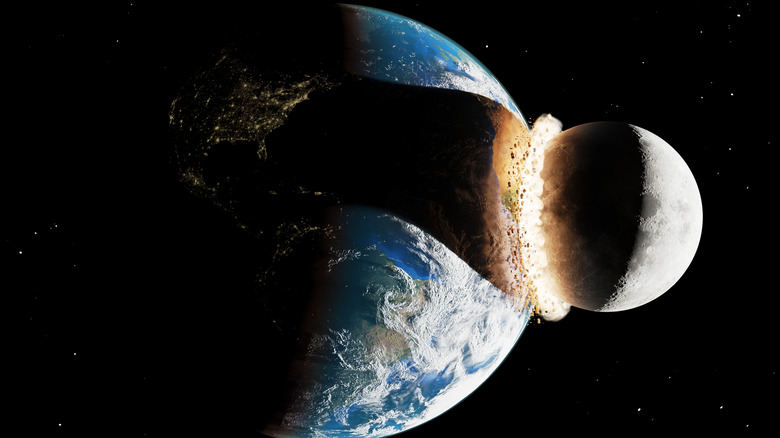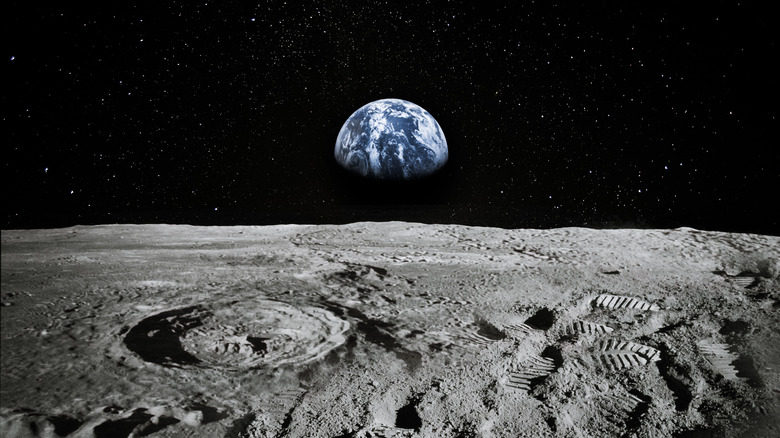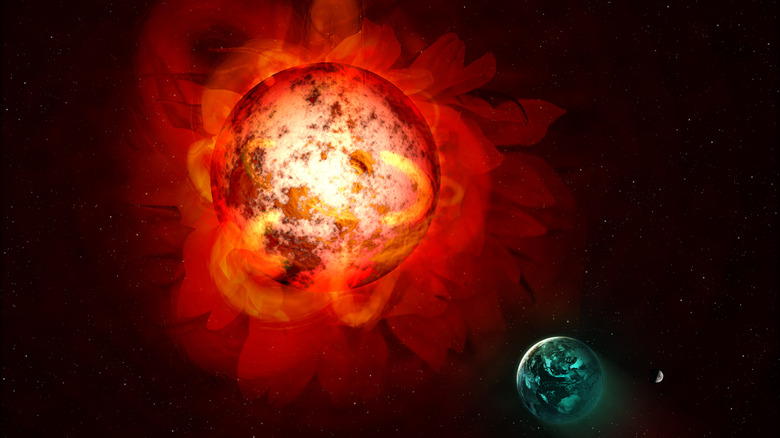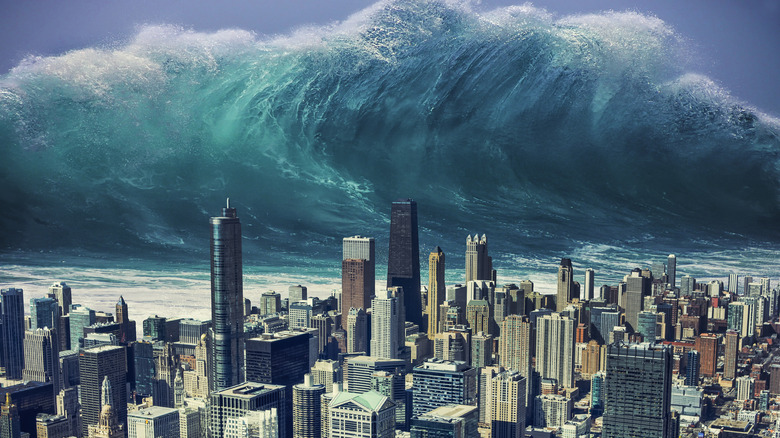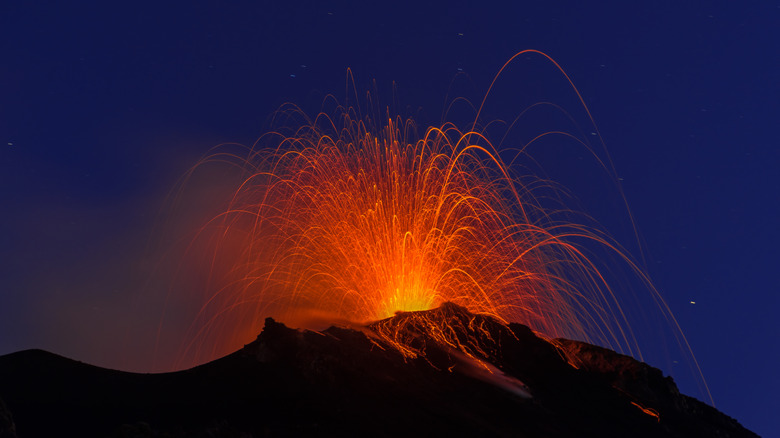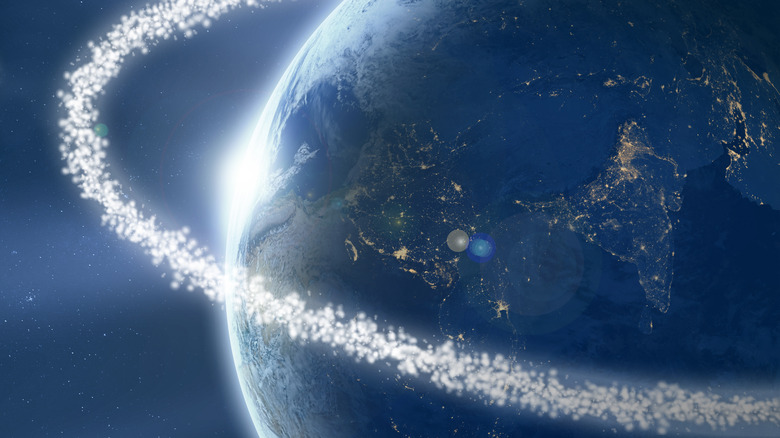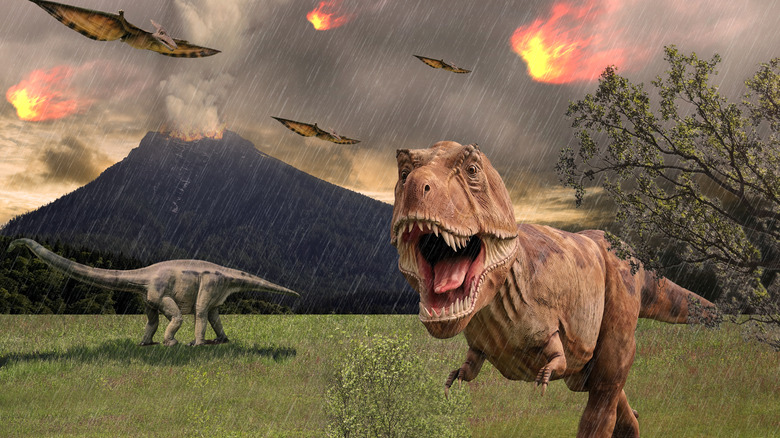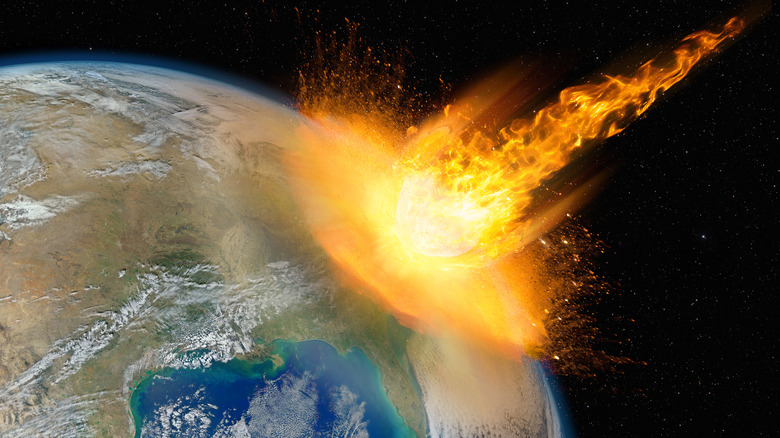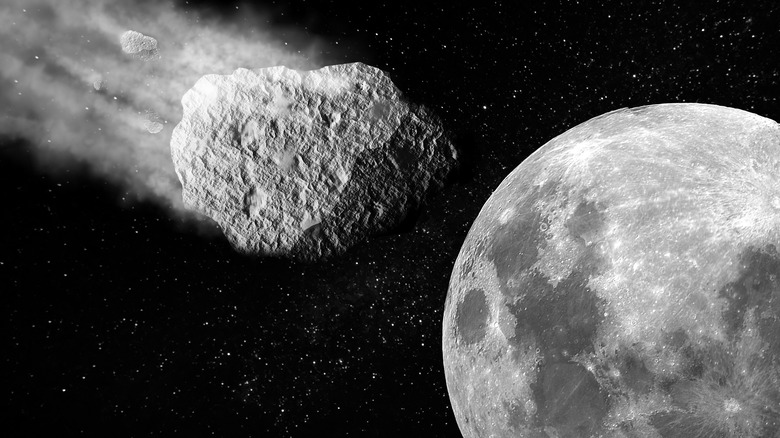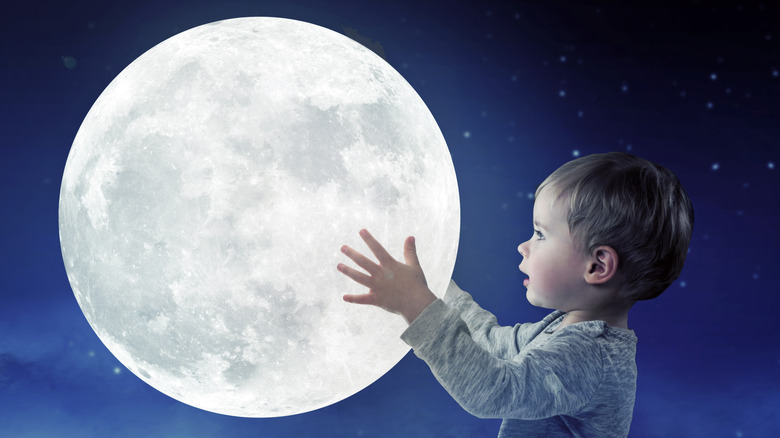Here's What Would Happen If The Moon Crashed On Earth
Our moon is Earth's only natural satellite and the fifth largest moon in the solar system. It is also the only celestial body upon which humans have ever set foot. According to the American Museum of Natural History, the moon was likely formed when Earth and another Mars-sized planet, given the name of Theia, crashed against each other about 4.5 billion years ago. The impact produced debris that went flying into space and eventually formed into our moon.
The moon has a significant influence on our planet. It controls the tides, stabilizes the climate, and makes Earth more livable — some scientists even think planets need objects like our moon to be capable of supporting complex life. Animals also make use of moonlight to hunt at night and guide themselves; birds use it to migrate and navigate. And although scientists aren't sure exactly how corals choose their one time per year to spawn, they do know it always happens after a full moon (via National Oceanic and Atmospheric Administration).
Can the moon also affect your mood, make you a little crazy, make people commit murder? While there are many questions about how (and if) the moon affects humans, the scientific evidence is so far inconclusive. Still, a 2013 study found that not only did it take participants a full five minutes longer to fall asleep on full moon nights, but they also spent less time in deep sleep (per Royal Museums Greenwich).
The moon's actually moving away from us
With the moon actually having such a big impact on life on Earth, what would happen if it got closer? Or even if it fell and crashed into our planet?
First, the good news: the moon actually spins away from Earth at a rate of 3.8 centimeters (1.5 inches) per year. This rate hasn't been constant, according to Insider — it has increased during times when the climate on earth changed, because the freeze and melt of glaciers affect the tides that exert gravitational pull on the moon. In those dramatic epochs, when the continents shifted and the conditions for life emerged, the moon instead drifted away at a rate of 2.75 inches a year.
Though this sounds slow, eventually, all this drifting will add up. In 50 billion years, the moon's orbit would grow from just over 27 days to 47 days, according to Futurism — assuming the sun didn't burn it up in its red giant phase. (More on that later.)
But in the distant future, things might be different
So with the moon moving away, there's nothing for you selenophobes to worry about, right? The bad news is that if you fast-forward 65 billion years from now, as Forbes explains, there's a chance the moon might actually change course and instead accelerate toward Earth. The reason is that the Earth's orbit will eventually slow to the point where it's the same as the moon's orbital period, which will gradually drag the moon inward.
Look on the bright side, though: Neither you nor anybody you know will be here to see it. And no other human probably will be, either. In just 4 or 5 billion years, the sun will explode into a red giant, according to Universe Today, possibly blowing up Earth and the moon. It will then retreat and become a white dwarf; if there's any Earth left, it will be frozen solid before the moon jams into it. Let's be optimistic: Maybe we will have colonized other solar systems by then.
Things start to get bad as soon as the moon moves closer
Let's say that for some reason which science cannot explain at the moment, this starts to happen much sooner than that — like in a few years. Maybe someone pushes on the moon, like aliens. Believe it or not, that might be the explanation in the 2022 disaster movie "Moonfall," according to the BBC's Science Focus magazine. It's semi-plausible.
"If you're an alien, I think you would need to put some propulsion engines on the lunar surface," said Tony Cook, a doctor of physics at Aberystwyth University. "I think you could probably deflect the orbit of the moon over a long period of time, but you would need an enormous amount of energy to do that, and probably have to do it gently, otherwise the moon might fall to pieces. A similar method has been proposed to change the direction of asteroids."
Even if it only happened slowly, it would be devastating. As the moon grew closer, coastal cities — think Tokyo, New York, London, and Mumbai — would be swallowed by monstrous tides (via Space Answers). Cook estimated that these tides would become eight times stronger than normal if the moon's distance was halved — and this would not be a one-time thing, either.
Volcanoes, earthquakes, end-of-the-world stuff
Things get scarier the closer the moon gets. At about 1,341 miles away — about as close to us as the International Space Station — the moon would fill up half the sky and miles-high tides would swell around the world many times a day, destroying absolutely everything in their path and then pushing the debris inland over and over again, according to Slate. What's worse is that this would happen every 90 minutes, since a moon at that distance would have a much faster orbit around Earth.
If that doesn't sound bad enough, remember that there will also be massive earthquakes, volcanic reactions, and an increase in the core temperature of the planet, since the nearness of the moon would literally stretch the earth toward it. In fact, if all the melted magma ended up released into the oceans, we could see the water simply boil away, according to Slate. But even if you somehow survived this apocalyptic calamity, the moon might not.
If the moon kept getting closer, at one point it would explode
Once the moon reached a distance of 11,470 miles above our planet, it would be at the Roche limit. By this point, the tidal waves on Earth would be about 30,000 feet tall, so nothing much would be left of life as we know it in coastal areas. As the moon got closer, it would have also affected the rotation of Earth, shortening days and affecting temperatures, making a new Ice Age very much a possibility over the long term (if you lived to see a long term — via INSH).
According to Space, once the moon reaches the Roche limit, it's all pretty much over. This is the point where tidal forces are stronger than gravity — meaning there are more forces pulling the Moon apart than holding it together. Soon, the moon will shatter into pieces and, at least for some time, these pieces will form a stunning ring around Earth, much like the rings around Saturn (per Space).
But the ring won't last forever. While there's not much risk of the entire moon crashing into Earth, pieces of debris will eventually start falling to Earth, destroying cities, causing massive craters, and potentially destroying all life on Earth, according to INSH. (In the far future, when this may actually happen, this won't matter too much, because the Earth will be on track to be incinerated by the sun during its red giant phase.)
Case study: the dinosaurs
You probably know that big pieces of debris shooting toward the Earth is less than ideal — you know what happened to the dinosaurs. But what would it do exactly? And how big is extinction-level big?
A long time ago — 66 million years ago, in fact — scientists believe an asteroid 7.5 miles in diameter collided into Earth at 27,000 mph, according to Live Science. The resulting impact wiped out not just the non-avian dinosaurs, but 80% of all life on the planet, in part because it hit at a particularly deadly angle of 60 degrees, which kicked up a lot of dust and aerosols that cooled the planet and blocked out the sun. Plants died and the food chain collapsed. Even marine animals weren't spared, thanks to the sulfuric acid released by the impact, which then fell into the oceans as huge amounts of acid rain.
The moon, mind you, is not just 7.5 miles wide. It's 2,159.1 miles wide. Even assuming that only 10% of the moon debris makes it to Earth, that's still an incredible threat.
The danger of a foreign object hitting earth
NASA's Planetary Defense Coordination Office (PDCO) monitors the sky for potential existential threats — and they haven't found any yet. But in looking at asteroids, they've set guidelines for what sort of effect space rocks falling to Earth would have. According to NASA, an asteroid that's 460 feet in diameter would probably produce "regional effects." A 984-foot asteroid, however, would produce "large sub-global effects," and a 0.6-mile asteroid, or larger, would be a worldwide catastrophe.
A foreign object the size of the one that killed the dinosaurs would probably kill most, if not all, humans. (Some, on the other side of the world from the impact and with sufficient shelter, may survive; in a blast identical to the impact that finished off the dinosaurs, the safest place would be Indonesia, Wired reports.) And according to Science Magazine, an asteroid would need to be about 60 miles wide to kill all life on Earth — plants, animals, and little one-celled prokaryotes alike. Even millimeter-wide tardigrades, the hardiest of all animals (they can survive for days in space, even without little microscopic astronaut suits), would die from such an impact, which would be so powerful that the oceans would boil into nothing, and produce 6x1026 joules of energy, or a million times the yearly energy consumption of humans.
Okay, but what if an asteroid hits the moon?
Now you're thinking creatively! Most foreign objects that could crash on the moon would not be large enough to change its orbit, according to the astronomer Alastair Gunn at BBC's Science Focus. For starters, the moon is orbiting pretty fast (0.6 miles per second, according to NASA), meaning that the force of its orbit is strong enough to shrug off anything that tried to knock it off course. Instead, the asteroid would simply create more craters on the surface of the moon. Even the dwarf planet Ceres — which, at a diameter of 587.82 miles, is the largest asteroid yet discovered — would not be able to careen the moon toward Earth.
If an object around the same size and speed as the moon rammed into it, though, things might be different. One of two things would happen. The far, far more likely outcome is that the moon would explode. The other outcome is that it changes the moon's orbit — toward Earth, possibly. But this is, of course, very unlikely. There aren't many objects in the solar system as big as the moon — even Pluto is smaller than the moon (per Space).
There are other things you can worry about
No planet-destroying asteroid is headed toward Earth or the moon, at least not any time soon as far as NASA knows (and it's been checking). AAliens are probably not going to fling the moon at us, either. If you wanted to find an existential threat to spend sleepless nights worrying about, there are plenty of others out there. The Existential Threat Observatory lists "unaligned A.I.," man-made pandemics, and future technology as the biggest risks facing humanity's survival; The Future of Life Institute also sees biotechnology and A.I. as big threats, along with climate change and nuclear war. That's five different, better things to worry about.
The moon might collide with Earth in the future, long after the planet is probably habitable. For now, you can just enjoy the moon for what it is — a beautiful presence in the sky, the stabilizer of Earth's climate, and a place humans have actually visited and played golf on. It's an orb we say "goodnight" to and pretend is made of cheese and count the seasons by. The moon can't hurt you. To repeat: the moon can't hurt you.
